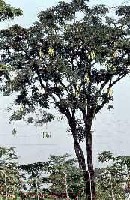| DESCRIPTION: It is a tree up to 15-40 m in height and with a trunk diameter of 50-100 cm. Leaves bipinnate on 2-6 cm long stalks. Pinnae 10-19 pairs, 5-9 cm long, each with 31-38 pairs of opposite linear leaflets, 5-9 mm long and about 2 mm wide. Pods large, 35-55 cm long and 3-5 cm wide, straight or more commonly twisted, dangling in small bundles, green becoming black. Each pod contains 10-18 large seeds. USE: Seeds are sometimes used as a vegetable and young leaves and fresh parts of the flower stalks are also edible. Wood is used for paper pulp and as timber. The seeds are used in local medicine against hepatalgia, oedema, nephritis, colic, cholera, diabetes and as an anthelmintic, and also applied externally to wounds and ulcers. The seeds are also valued as a carminative. The tree is planted for shade and shelter. GROWING PERIOD: Perennial. COMMON NAMES: u‚pang, petai, chou dou, sataw. FURTHER INF: It is a native of the Malay Peninsula, growing wild in lowland forests, often cultivated in Malay kampongs. It has been cultivated in Java since ancient times. It occurs in scattered lowland rainforests and sometimes also in tall secondary forest, on sandy, loamy and podzolic soils, also in waterlogged locations, in freshwater swamp forest and on riverbanks. The tropical lowland tree requires some shade when young. |
